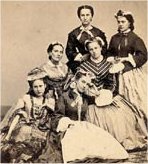
Worksheets and No Prep Teaching Resources
Reading Comprehension Worksheets
Women's History
The Civil War
(1861-1865)

Women's History
 Worksheets and No Prep Teaching Resources Reading Comprehension Worksheets Women's History The Civil War (1861-1865) |
 Women's History |
| edHelper's suggested reading level: | grades 5 to 7 | |
| Flesch-Kincaid grade level: | 8.28 |
|
Women in the Civil War
By Sharon Fabian |

|
 1 Lottie Moon married Judge Clark. Both Lottie and the judge were active supporters of the Confederacy, and when war messages had to be sent in secret, the couriers often stopped by the judge's house. One time they needed a new courier, someone who could slip by without being recognized as a messenger. Lottie volunteered. This is how she began her career as a Civil War spy. After that first trip, she continued to work undercover for the Confederacy. She had official-looking papers that said she was a British citizen; these helped her to travel almost anywhere without suspicion.
1 Lottie Moon married Judge Clark. Both Lottie and the judge were active supporters of the Confederacy, and when war messages had to be sent in secret, the couriers often stopped by the judge's house. One time they needed a new courier, someone who could slip by without being recognized as a messenger. Lottie volunteered. This is how she began her career as a Civil War spy. After that first trip, she continued to work undercover for the Confederacy. She had official-looking papers that said she was a British citizen; these helped her to travel almost anywhere without suspicion. |
Create Weekly Reading Books
Prepare for an entire week at once! |
| Leave your feedback on Women in the Civil War (use this link if you found an error in the story) |
 |
Women's History
|
 |
The Civil War (1861-1865) |
 |
Harriet Tubman Activities, Worksheets, Printables, and Lesson Plans
|
 |
United States
|
|
|
 | Fifty States Theme Unit |
 |
Document Based Activities |